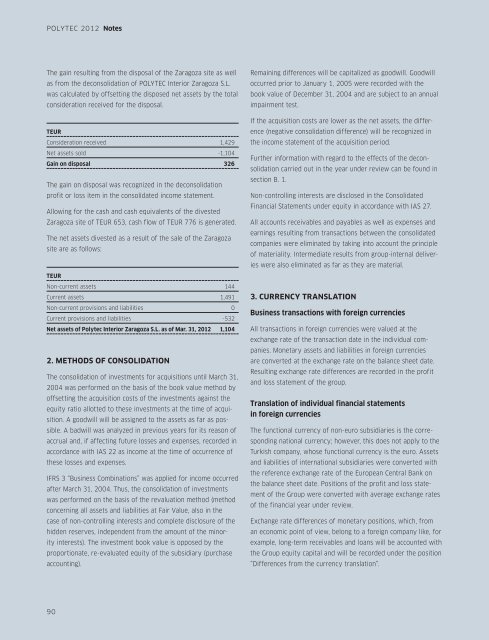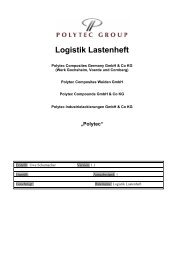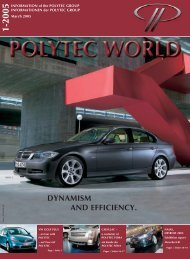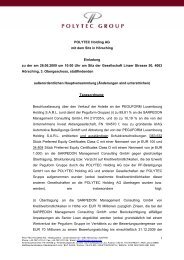Download - polytec
Download - polytec
Download - polytec
Create successful ePaper yourself
Turn your PDF publications into a flip-book with our unique Google optimized e-Paper software.
POLYTEC 2012 Notes<br />
The gain resulting from the disposal of the Zaragoza site as well<br />
as from the deconsolidation of POLYTEC Interior Zaragoza S.L.<br />
was calculated by offsetting the disposed net assets by the total<br />
consideration received for the disposal.<br />
TEUR<br />
Consideration received 1,429<br />
Net assets sold -1,104<br />
Gain on disposal 326<br />
The gain on disposal was recognized in the deconsolidation<br />
profit or loss item in the consolidated income statement.<br />
Allowing for the cash and cash equivalents of the divested<br />
Zaragoza site of TEUR 653, cash flow of TEUR 776 is generated.<br />
The net assets divested as a result of the sale of the Zaragoza<br />
site are as follows:<br />
TEUR<br />
Non-current assets 144<br />
Current assets 1,491<br />
Non-current provisions and liabilities 0<br />
Current provisions and liabilities -532<br />
Net assets of Polytec Interior Zaragoza S.L. as of Mar. 31, 2012 1,104<br />
2. METHods of consolidation<br />
The consolidation of investments for acquisitions until March 31,<br />
2004 was performed on the basis of the book value method by<br />
offsetting the acquisition costs of the investments against the<br />
equity ratio allotted to these investments at the time of acquisition.<br />
A goodwill will be assigned to the assets as far as possible.<br />
A badwill was analyzed in previous years for its reason of<br />
accrual and, if affecting future losses and expenses, recorded in<br />
accordance with IAS 22 as income at the time of occurrence of<br />
these losses and expenses.<br />
IFRS 3 “Business Combinations” was applied for income occurred<br />
after March 31, 2004. Thus, the consolidation of investments<br />
was performed on the basis of the revaluation method (method<br />
concerning all assets and liabilities at Fair Value, also in the<br />
case of non-controlling interests and complete disclosure of the<br />
hidden reserves, independent from the amount of the minority<br />
interests). The investment book value is opposed by the<br />
proportionate, re-evaluated equity of the subsidiary (purchase<br />
accounting).<br />
Remaining differences will be capitalized as goodwill. Goodwill<br />
occurred prior to January 1, 2005 were recorded with the<br />
book value of December 31, 2004 and are subject to an annual<br />
impairment test.<br />
If the acquisition costs are lower as the net assets, the difference<br />
(negative consolidation difference) will be recognized in<br />
the income statement of the acquisition period.<br />
Further information with regard to the effects of the deconsolidation<br />
carried out in the year under review can be found in<br />
section B. 1.<br />
Non-controlling interests are disclosed in the Consolidated<br />
Financial Statements under equity in accordance with IAS 27.<br />
All accounts receivables and payables as well as expenses and<br />
earnings resulting from transactions between the consolidated<br />
companies were eliminated by taking into account the principle<br />
of materiality. Intermediate results from group-internal deliveries<br />
were also eliminated as far as they are material.<br />
3. Currency translation<br />
Business transactions with foreign currencies<br />
All transactions in foreign currencies were valued at the<br />
exchange rate of the transaction date in the individual companies.<br />
Monetary assets and liabilities in foreign currencies<br />
are converted at the exchange rate on the balance sheet date.<br />
Resulting exchange rate differences are recorded in the profit<br />
and loss statement of the group.<br />
Translation of individual financial statements<br />
in foreign currencies<br />
The functional currency of non-euro subsidiaries is the corresponding<br />
national currency; however, this does not apply to the<br />
Turkish company, whose functional currency is the euro. Assets<br />
and liabilities of international subsidiaries were converted with<br />
the reference exchange rate of the European Central Bank on<br />
the balance sheet date. Positions of the profit and loss statement<br />
of the Group were converted with average exchange rates<br />
of the financial year under review.<br />
Exchange rate differences of monetary positions, which, from<br />
an economic point of view, belong to a foreign company like, for<br />
example, long-term receivables and loans will be accounted with<br />
the Group equity capital and will be recorded under the position<br />
“Differences from the currency translation”.<br />
90
















